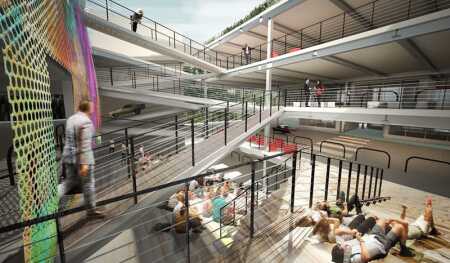At the 1939 World’s Fair in New York City, industrial designer Norman Bel Geddes presented “Futurama,” an exhibit of automated highways and vast, sprawling suburbs that envisioned a world 20 years into the future. Though not the first prediction of autonomous vehicles (AVs), “Futurama” was an early model of how their introduction could make the cityscape more efficient, with a multitiered structure separating pedestrian traffic from the seamless flow of cars below. With the rate of automobile use exploding in the 1930s, Geddes’s depiction sought primarily to address the issue of traffic congestion.
Fast-forward to nearly 80 years later, the wave of AVs is finally rising just as city living is more popular than ever—accounting for over 54 percent of the global population and predicted to grow every year for at least the next decade. Technology companies and automakers alike are competing to rule the road, testing their fleets in cities around the country. But this is just the beginning of an even larger discussion about the impact of AVs—and how they are going to completely redesign the city as we know it.
This inevitable urban revolution begins with revised roadways. Car-to-car communication between autonomous vehicles will ensure that traffic moves smoothly, making signals at intersections obsolete and eliminating the need for extra lanes. AVs also will know exactly how fast they should travel, follow one another much closer to prevent traffic congestion, shorten commute times, avoid accidents, and reduce air pollution. Removing the human error responsible for 93 percent of all automotive accidents could make the roadways safer and more efficient. Highway developers are already envisioning a near future with dedicated AV lanes, like the high-occupancy-vehicle (HOV) lanes of today.
But the impact of autonomous vehicles will be felt far beyond what happens on the streets. A city experience that has relied on cars for the past century will swing toward a much more people-focused design. With less space for the 260 million cars, motorcycles, and buses on U.S. roads, bike lanes and sidewalks will be free for widening, leading to more space for pedestrians. Street-side parking lanes will be transformed into sidewalk cafés, and buildings will be reshaped, with the front door replacing the parking garage as the primary point of entry. This newly freed space will make way for amenities and mixed-use projects with apartments, offices, stores, and community gathering places, bringing new life to the already vibrant cityscape.
As car ownership declines and ride sharing explodes, AVs represent the path toward a new and improved city living experience. Fewer young people are bothering to get their driver’s licenses—71 percent of 16- to 24-year-olds in 2013, compared with 76 percent in 2000—and if the trend continues, they may simply hail a ride when they need one. Eliminating the need to own a car, fleets of AVs will constantly circulate though the city, providing on-demand service.
With constantly moving cars, a parking industry overhaul is unavoidable. At any given moment, in any city, thousands of cars are parked in one of at least 500 million parking spaces nationwide—more than one per person. The enormous parking surplus had made sense until now, given that cars typically spend about 95 percent of their time in parking spaces. But as autonomous vehicles reach the mainstream, they likely will take on new forms—a narrower, less bulbous shape that will allow them to get closer together, taking advantage of their constant communication with each other and the roadway.
This inevitably will lead to broad renovation of antiquated parking decks—large, unappealing concrete structures that will quickly become outdated and need to be repurposed. Traditionally designed with sloping or staggered floors, parking is their only realistic application; to be reused, they will certainly need to be demolished.
Developers with foresight have already been creating garages with flat floors and exterior ramps, offering a quicker path to conversion of the space to accommodate amenities, apartments, or offices that can fill gaps from lost parking revenue. Without parking garages, drop-off zones will need to expand dramatically, and building lobbies will evolve as they become the first point of interaction for visitors.
Furthering this ripple effect, gas stations will disperse until they eventually disappear or turn into charging stations. Automobile insurance may vanish as well, and car payments will no longer be made monthly, but instead become pay-per-ride charges as ride hailing becomes the preferred mode of transportation. With an estimated 71 million autonomous vehicles on the road by 2030, widespread adoption is likely within the next decade.
Still, the road to a fully autonomous future is long and winding. Just as Geddes work on “Futurama” looked forward—defining a problem not yet encountered—by anticipating the effects autonomous vehicles will have on our cities today, we can prepare for a better tomorrow.
Andy Cohen is co–chief executive officer of Gensler.





